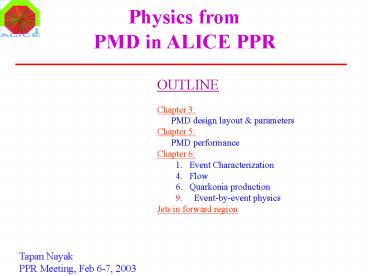Physics from PowerPoint PPT Presentation
1 / 30
Title: Physics from
1
Physics from PMD in ALICE PPR
- OUTLINE
- Chapter 3
- PMD design layout parameters
- Chapter 5
- PMD performance
- Chapter 6
- 1. Event Characterization
- 4. Flow
- 6. Quarkonia production
- Event-by-event physics
- Jets in forward region
Tapan Nayak PPR Meeting, Feb 6-7, 2003
2
(No Transcript)
3
PMD
V0
4
PMD Split Position
5
PMD Parameters
6
Chapter 6.1 Centrality Estimation using PMD
We define ET_PMD ? dE Sin (?) The
sum run over all the cells and dE is energy loss
in a given cell.
Simulation using HIJING Aliroot
Total trans. Energy vs Npart
7
Impact Parameter Resolution
- Resolution comparable
- to ZDC
- We are now studying
- this using different
- pseudo-rapidity region
- of PMD
- A simple EDEP sum
- without the sin(theta)
- gives better results. This
- can be easy to implement
- in hardware.
8
Chapter 6.4 Flow
By using eff, purity and decay effect the
photon data is prperly understood with respect to
charged particles.
Chapter 6.6 Quarkonia Production already
included.
9
Chapter 6.9 Event-by-Event Fluctuations
- J.D. Bjorken 1992
- Rajagopal Wilczek 1993
10
MEASURES OF FLUCTUATIONS
Space-time evolution of fluctuations are
important!
11
158.A GeV PbPb at SPS
STATISTICAL DYNAMICAL
12
Multiplicity Fluctuation
Multiplicity distributions are GAUSSIANS
for narrow bins in centrality. The physics
(statistical dynamical) is in the width of the
distribution. The amount of fluctuation
w s2/ lt N gt
13
Centrality Selection
14
Centrality Selection
Fluctuation in number of participants
Fluctuation should be measured and calculated
for narrow bins in centrality (2 cs bins ) such
that fluctuations in Npart is unity.
15
Multiplicity Fluctuations for various centralities
Charged Particles
Peripheral
Central
Data agree fairly well with participant model
calculations
16
Detector Acceptance
Mohanty, Phatak Mahapatra Int. J. Mod. Phys. A
17 (2002) 675
- A Simple Statistical Picture
- No. of particles produced in the collision m
- No. of particles accepted in the acceptance n
- Fraction of particles accepted f n/m
- The distribution of n follows a binomial
distribution with - mean mf variance mf(1-f).
- For a fixed m wn 1-f
- For m having an arbitrary distribution,
- wn 1 f f wm
By knowing the fluctuation in one acceptance, one
can get expected fluctuation in other
acceptances.
17
Acceptance dependence of Multiplicity Fluctuations
Charged Particles
Dh 1
Dh 1/2
Data agree fairly well with participant model
calculations based on binomial sampling
18
Fluctuations of Ch. particles vs. Photons To
search for DCC-like fluctuations
- Discrete Wavelet Analysis
- Correlation Analysis
Single event display gt Charged particles
superimposed on photons
19
FLUCTUATIONS by using WAVELETS
- Analysis according to scale
- Number of bins 2j where j is the
scale
Input function no. of Particles in a
bin Output Father function Coefficients (FFC)
at each j.
Provide a new mindset in Data Analysis.
20
Ng vs. Nch FLUCTUATIONS
- Correlation Analysis
Localized phase fluctuations
21
Formation of DCC upper limits
Global DCC
0-5 central
- Localized fluctuations decrease
- from central to peripheral.
- Upper limit for DCC-like
- localized fluctuations 3x10-3
- for central collisions.
1. Phys.Lett.B420169-179,1998 2.
Phys.Rev.C64011901,2001 3. nucl-ex/0206017, to
be published in PRC Krzywicki Serreau Phys.
Lett.B 448 (1999) 257
22
DCC search Possibilities and Limitations
Mohanty, TN, Mahapatra, Viyogi nucl-ex/0211007
- Effect of Multiplicity
- lower statistical fluctuation in going
from SPS to RHIC to LHC - Effect of pi0 decay
- Effect of multiple DCC domains
- if the domains dont overlap it is still
possible to look for these. - Effect of detector limitations
- Charged particle contamination on photon
measurement - This is a serious limitation.
- Efficiency of photon detection
- Having pT information for charged particles
only - Helps in DCC search to a large extent.
- Having pT information for photons only
- This effect is not so appreciable because
of pi0 decay effects. - Having pT information for both charged
particles and photons - Signal to background in case DCC domain is
photon excess or - charged particle excess (photon excess has
higher S/B)
23
A Fluctuation probe for DCC
Mohanty, TN, Mahapatra Phys.Rev.C66044901,2002
24
DCC search at RHIC and LHC
- Using charged particle and photon multiplicities
- classify events based on wavelet or correlation
analysis as - Normal events which are within 2 or 3 sigma from
the mean - Not-so-Normal events beyond that.
- For both set of events measure and compare the
following proposed signals - Kaon correlations (KsK vs KK-) Gavin,
Kapusta - Two-particle (HBT) correlations Gavin
- Dilepton signals
Koch, Randrup, X-N Wang - Omega and anti-Omega abundances Kapusta, SMH
Wong - Direct photons
Charng et al. (Phys.Lett. B548 (2002) 175 - Pion Lasers
Sinyukov Pratt - DCC and Flow
Mishra, Nandi, TN, Mohanty, Mahapatra
25
Jets in forward region
50,000 PYTHIA jet events
- In the PMD acceptance
- Photons 346
- Pi_0 3374
Plenty of jets
26
Energy of photons Pi-0s (Leading particle)
27
Jet cross-section from D0
PRL 86 (2001) 1707
At LHC it should be larger
28
What can we do in ALICE
Low-cost EM-calorimeter behind PMD (pp physics,
jets, E_t Flow.)
Five planes of 1cm lead 5mm Scintillator
29
Preliminary results of simulation for the EMCAL
Energy deposition vs. incident energy
PMD cells vs. incident energy
Combine the Edep data and N-cell data to improve
resolution. (principal component analysis)
30
Fluctuation not too large

